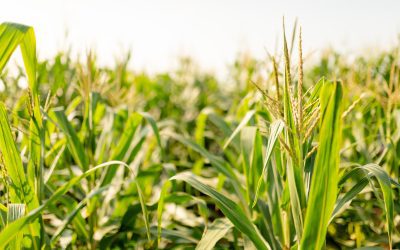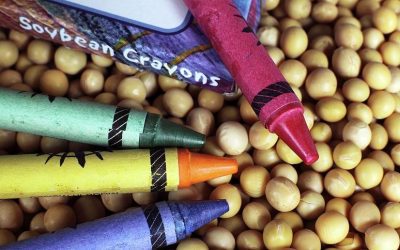Select Hoosier farmers, checkoff staff get early peek at August Crop Report
Posted: November 2, 2022
Category:
ICMC, Indiana Corn and Soybean Post - Fall 2022, ISA, News
Similar to a scene from a Hollywood movie, Indiana farmers, corn and soybean checkoff staff were moved from room-to-room and several levels of government security prior to the release of the USDA’s August Crop Report on Aug. 12 in the USDA building in Washington, D.C. The August Crop Report is a key indicator for farm commodity analysts because it is released just weeks before harvest.
For many years, USDA releases this information early to a group of farmers from across the country, and it shares with those farmers the process of how the crop estimates were determined. USDA does this to maintain an “open door” to the public regarding its work. This is known as the Lockup for the August Crop Report.
Since the sensitive “insider information” could impact commodity markets if released too early, no one attending the Lockup could have cell phones or any other electronic devices during the briefing.
Steve Phares, an Indiana Soybean Alliance (ISA) board member and farmer from Albion, Ind., was among a group of farmers who attended. “The thing that probably impressed me the most was how serious they were about security,”
Phares said. “They took our cell phones, and they were adamant about not sharing any information before the report was released publicly.”
In addition to Phares, others attending were ISA board member Joe Stoller, a farmer from Bremen, Ind.; Indiana Corn Marketing Council (ICMC) board member Jerry Osterholt, a farmer from Roanoke, Ind.; ISA board member Brian Warpup, a farmer from Warren, Ind.; Ed Ebert, ICMC, ICGA and ISA senior market development director; Khyla Goodman, ICMC, ICGA and ISA industry affairs outreach and membership manager; and Maggie Hancock, ICGA, ICMC and ISA market development project manager.
About 45 minutes prior to the release of the crop production report, guests were able to see the data in the Lockup room. The briefing was led by Lance Hoenig, NASS crops branch chief.
“We went through security to go into the USDA building. They then took us to another room and took our cell phones away and other personal belongings. Then we went to another room, and they briefed us on how they get all of their statistics. NASS was there and from there they took us to the lockup room where there was another security checkpoint before we went in there,” Stoller said.
“When we sat down in the Lockup room, they already had printouts of the report ready for us. We probably knew the results maybe 40 minutes prior to its public release. It was really neat to see how these numbers are compiled and how these reports are put out. It’s interesting. It’s a little more secure than I would have thought. I’ve always been a little skeptical thinking that maybe the reports are leaked the night before or something, but I don’t really think they are.”

Getting the numbers right
“This is important information not only for farmers, but for processors and others who buy and use corn, soybeans and wheat,” Phares says. “I got the impression that they really try hard to get this right. They have a process to come up with realistic estimates, and they follow the process.
“Other things besides crop yield go into market prices, such as exports and the potential for exports. Yet U.S. crop yields are a big part of what will affect crop prices.”
The USDA August crop report estimated the corn yield at 175.4 bushels per acre nationally, down from the near trend line yield forecast of 177 bushels. The average national soybean yield was estimated at 51.9 bushels per acre, up from the 51.5-bushel trend yield.

Phares found the Indiana yield estimates more interesting. USDA set the 2022 Indiana average corn yield at 189 bushels per acre, compared to 190 bushels in Ohio and 203 bushels in Illinois. The projected Indiana average soybean yield at 60 bushels per acre would be a record.
“I was somewhat surprised that the crop yield estimates for Indiana were that high,” Phares said. “We were very dry in June, but then we got rain in early July in my area. Our crops are looking pretty good.”
Osterholt agreed with most of the report. “(USDA) said the Indiana soybean yield was going to be a record this year,” he said. “I was surprised at that because my soybeans don’t look like they’re going to be a record, but hopefully I’m pleasantly surprised.”
Osterholt believes the corn yield forecast was reasonable. “I think I can do that,” he said.
Stoller, too, was surprised. “That kind of caught me a little off-guard. I just don’t quite see it. That’s a pretty lofty goal,” he said of the corn estimate. “We got really dry early on for about two weeks after July 4. I think the top end of the crop was hurt, at least on the corn. Now we are seeing some rain and a little cooler weather, but now we’re seeing tar spot, too.”
Warpup said he may see yields close to the USDA estimates “We were very dry early on,” he said. “But I had 7 inches of rain in July, which really helped turn the corn crop around. I have walked my fields of corn, and I feel very positive about the outlook of my corn crop. Beans, as well, we still need some rains in August to finish those beans out.”
Planning for the future
Warpup was amazed by the extent of the data collected from across the country for predicting fall crop yields. “It was tens of thousands of pieces of information that they get to pull this report together,” he explained. “I believe in the process and feel it’s more accurate than what I felt it once was.”
Osterholt was equally impressed. USDA coordinates information with National Agricultural Statistics Service employees across the country. “It’s amazing the work they do.”
He said the crop report is important because it allows farmers to gauge how much they will make on their crops this year and how much they can afford to spend on fertilizer and other inputs for next year.
Warpup said this report has started his planning for the next growing season. “Going into the 2023 crop year, I’ll probably fine-tune a lot of numbers just to try and put out more corn because as long as demand is still there in my area, my goal would be to grow more corn,” he said.
However, input costs remain the wildcard. “With corn inputs up substantially over the last six months, going into a new crop year I would have to rake over the prices to see if it is evident that corn return just a little bit more on my farm,” Warpup said.



